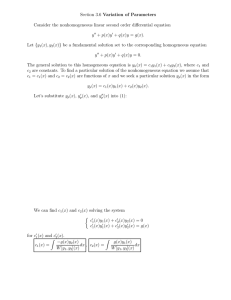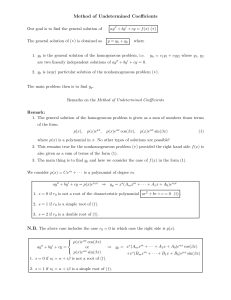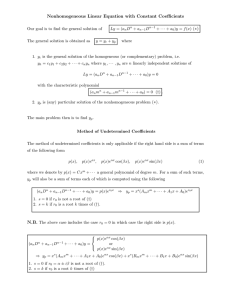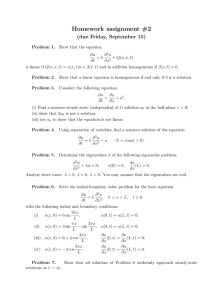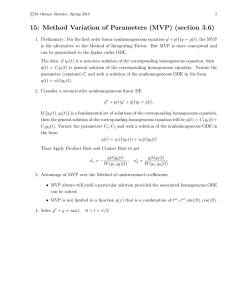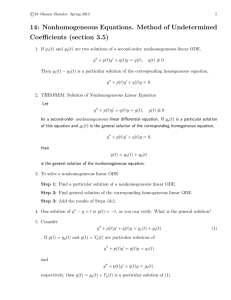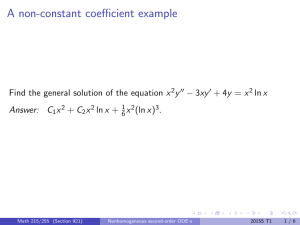1 Nonhomogeneous Equations 1.1 Generalities
advertisement
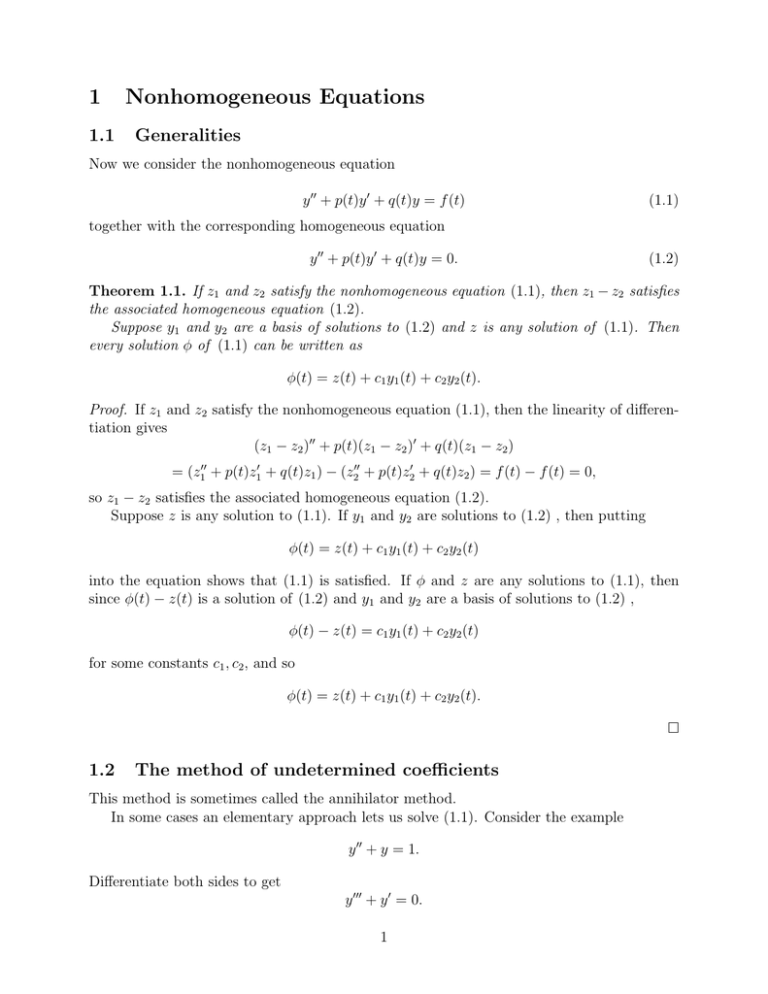
1 1.1 Nonhomogeneous Equations Generalities Now we consider the nonhomogeneous equation y 00 + p(t)y 0 + q(t)y = f (t) (1.1) together with the corresponding homogeneous equation y 00 + p(t)y 0 + q(t)y = 0. (1.2) Theorem 1.1. If z1 and z2 satisfy the nonhomogeneous equation (1.1), then z1 − z2 satisfies the associated homogeneous equation (1.2). Suppose y1 and y2 are a basis of solutions to (1.2) and z is any solution of (1.1). Then every solution φ of (1.1) can be written as φ(t) = z(t) + c1 y1 (t) + c2 y2 (t). Proof. If z1 and z2 satisfy the nonhomogeneous equation (1.1), then the linearity of differentiation gives (z1 − z2 )00 + p(t)(z1 − z2 )0 + q(t)(z1 − z2 ) = (z100 + p(t)z10 + q(t)z1 ) − (z200 + p(t)z20 + q(t)z2 ) = f (t) − f (t) = 0, so z1 − z2 satisfies the associated homogeneous equation (1.2). Suppose z is any solution to (1.1). If y1 and y2 are solutions to (1.2) , then putting φ(t) = z(t) + c1 y1 (t) + c2 y2 (t) into the equation shows that (1.1) is satisfied. If φ and z are any solutions to (1.1), then since φ(t) − z(t) is a solution of (1.2) and y1 and y2 are a basis of solutions to (1.2) , φ(t) − z(t) = c1 y1 (t) + c2 y2 (t) for some constants c1 , c2 , and so φ(t) = z(t) + c1 y1 (t) + c2 y2 (t). 1.2 The method of undetermined coefficients This method is sometimes called the annihilator method. In some cases an elementary approach lets us solve (1.1). Consider the example y 00 + y = 1. Differentiate both sides to get y 000 + y 0 = 0. 1 Third order equations have 3 independent solutions. N -th order equations have N independent solutions. When the coefficients are constant, guessing exponential solutions works.(When there are repeated roots, an extended method is required.) Look for solutions of the form er t to get r3 + 3r = 0, giving r = 0, ±i. The solution of the original equation must have the form y = c1 eit + c2 e−it + c3 . Plug this into the original nonhomogeneous equation to get c3 = 1. A particular solution is yp (t) = 1, and the general solution is y(t) = 1 + c1 eit + c2 e−it . As the examples grow more complicated, it helps to modify the notation. Use D to denote differentiation. Consider the example y 00 − 3y 0 + 2y = 1 + 2t. Write it as D2 y − 3Dy + 2y = 1 + 2t. Apply D2 to get D2 (D2 y − 3Dy + 2y) = 0. The characteristic polynomial, obtained by looking for solutions ert is r2 (r2 − 3r + 2) = r2 (r − 2)(r − 1) = 0, which just replaces D by r. The solution y must have the form y(t) = c1 e2t + c2 et + c3 + c4 t. Putting this into the nonhomogeneous equation yields −3c4 + 2(c3 + c4 t) = 1 + 2t, or c4 = 1, c3 = 2. Thus a particular solution yp is yp (t) = 2 + t, and the general solution is y(t) = c1 e2t + c2 et + 2 + t. Another example is y 00 − 3y 0 + 2y = e−t + 1, 2 or (D − 2)(D − 1)y = e−t + 1. Applying D knocks out the 1, and D + 1 knocks out e−t , so D(D + 1)(D − 2)(D − 1)y = 0, and y = c1 + c2 e−t + c3 et + c4 e2t . The general solution is 1 1 −t + e + c3 et + c4 e2t . 2 6 y(t) = A physically important example is y 00 + 4y = sin(2t). This is forcing at the natural frequency. (D2 + 4)y = sin(2t), (D2 + 4)2 y = (D + 2i)2 (D − 2i)2 y = 0. Then y(t) = c1 e2it + c2 te2it + c3 e−2it + c4 te−2it , or y(t) = c1 cos(2t) + c2 t cos(2t) + c3 sin(2t) + c4 t sin(2t). After some algebra the general solution is y(t) = c1 cos(2t) + c2 sin(2t) − t cos(2t). 4 For the method to work we want f (t) to be a linear combination of terms of the form t e . If roots are repeated with multiplicity m, then terms up to tm−1 ert may be needed. k rt 3
